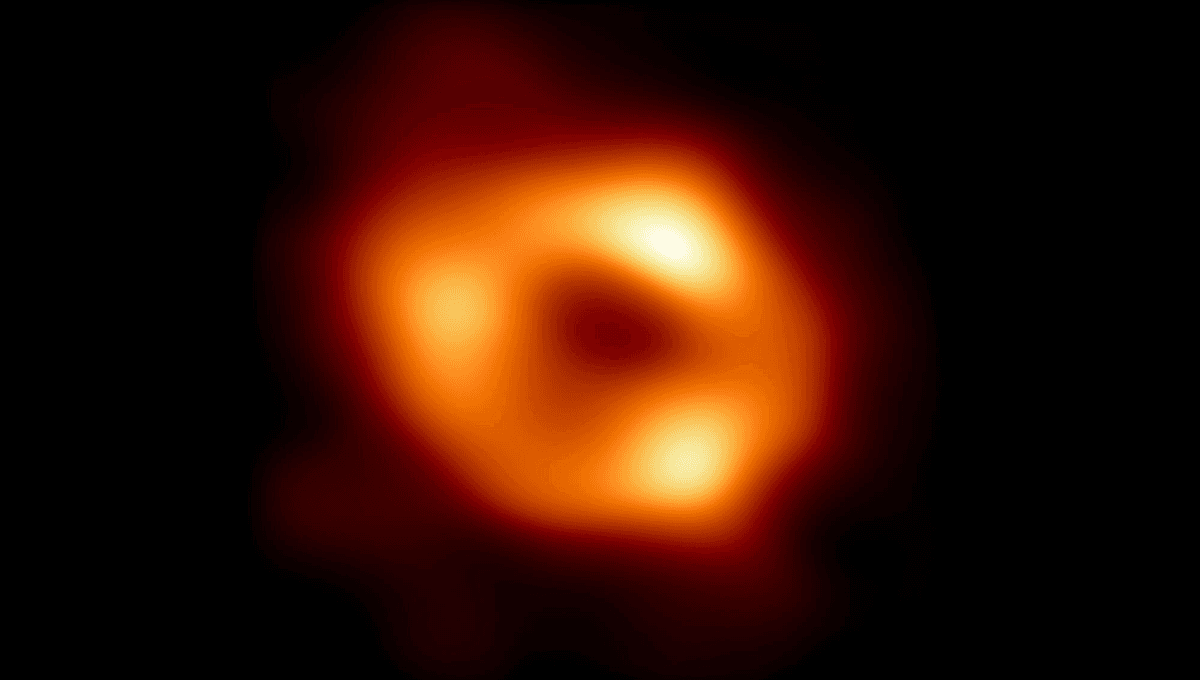
The giant black hole at the center of our galaxy has an unexpected spin, which is likely to be the result of a merger with another large black hole. The merger almost certainly occurred with the smaller, but still technically supermassive, black hole at the heart of a galaxy that was swallowed by the Milky Way.
The Event Horizon Telescope’s first image of a black hole, and the follow up of our own galaxy’s Sagittarius A*, triggered great excitement. Two astronomers think they have noticed something in the latter images that others missed. They conclude that Sagittarius A* is spinning surprisingly fast for an object of its age and size. Moreover, its direction of spin is not aligned with that of the Milky Way galaxy as a whole, as would be expected.
Dr Yihan Wang and Professor Bing Zhang of the University of Nevada, Las Vegas argue these features represent the legacy of a major merger with a black hole of comparable size.
There is still debate about the origins of the Supermassive Black Holes (SMBHs) that lie at the heart of most, if not all, medium or large galaxies. Once they come into existence, however, there are two processes by which they grow to become hundreds of millions or tens of billions of times as massive as the Sun. One of these is accretion, where gas spirals into the SMBH, creating a blazing disk in the process.
The second process is through mergers with other black holes. Because SMBHs are much rarer than stellar black holes, and their mergers rarer still, we have yet to detect the gravitational waves from such colossal events. However, there are plenty of reasons to be confident it happens: we see galaxies merging, and the evidence for past mergers in the Milky Way. When that happens, the black holes are expected to initially orbit each other. Eventually, however, such orbits will decay, and a merger will create something even more supermassive.
Debate remains as to the relative importance of accretion and mergers, with the “hierarchical black hole merger theory” arguing for the importance of the latter.
Now it seems we have evidence close to home (by cosmic standards).
When stars merge the angular momentum donated by the smaller object can cause the product to speed up. This has been considered the most likely explanation for some anomalously fast-spinning stars, and astronomers have been able to calculate likely characteristics of the object concerned. It makes sense for the same process to occur for SMBHs, but it’s harder to do forensics on an object we only visualize from its shadow rather than seeing directly.
Nevertheless, Wang and Zhang suspect the merger took place 9 billion years ago, when the Milky Way merged with the Gaia-Enceladus Galaxy and the ratio between the two SMBHs’ masses was 4:1.
If Gaia-Enceladus had approached from approximately in the direction of the Milky Way’s plane, Sagittarius A* would spin fast, but there would be no clear clue to the cause. However, the apparently steep angle between the direction the hole spins in and the galactic axis of rotation is more suspicious. The pair modeled different scenarios and found only an angle of inclination of 145-180° between the incoming Gaia-Enceladus SMBH and Sagittarius A*’s previous spin explains what we know. They argue that some accretion models could explain the rate of spin, but not the angle, and others the angle but not the rate.
We can detect an SMBH’s spin by the way it affects the movement of nearby objects, and we expect them to usually rotate in the plane of the galaxy as a whole, having formed together. It resembles the way most stars, including our Sun, rotate with an equator roughly aligned to the orbits of their planets.
“This discovery paves the way for our understanding of how supermassive black holes grow and evolve,” said Wang in a statement. “The misaligned high spin of Sgr A* indicates that it may have merged with another black hole, dramatically altering its amplitude and orientation of spin.”
“This event not only provides evidence of the hierarchical black hole merger theory but also provides insights into the dynamic history of our galaxy,” Zhang said.
More advanced gravitational wave detectors in space are planned, with one reason being to detect SMBH mergers from similar eras to when this event occurred. Such waves are too weakened by wobbling so much spacetime to be picked up by existing systems. Wang and Zhang consider the merger they describe an encouraging sign for the idea these events were once common enough the planned equipment should be able to find some.
The study is published open access in Nature Astronomy.
Source Link: An Ancient Merger Put The Milky Way’s Supermassive Black Hole In A Spin